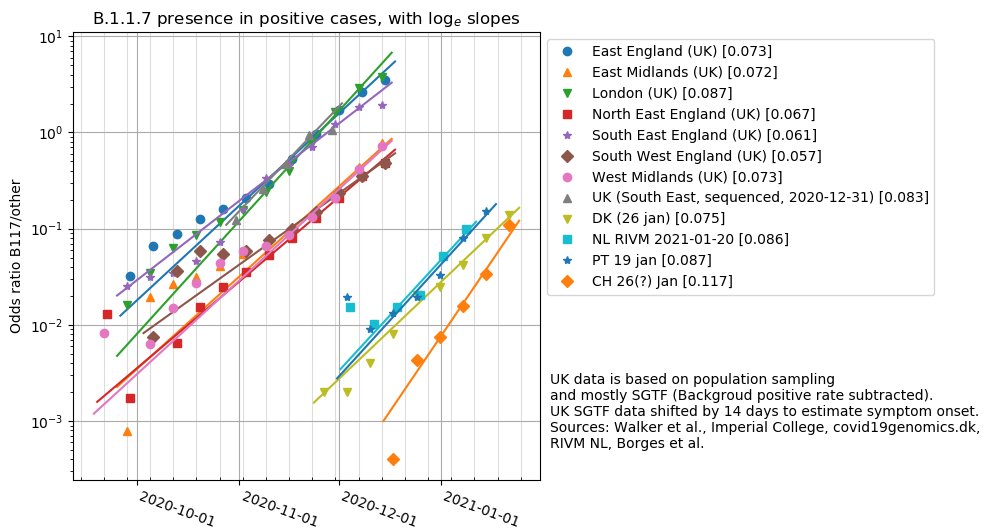
1/ In a recent publication, Walker et al. [medrxiv.org/content/10.110…] suggested that the B.1.1.7 coronavirus strain was less transmissible than previously thought, growing only 6 %/day relative to other strains, rather than 11 %/d. Let's have a closer look.
#B117
#B117
2/ Fig. 4 shows a daily growth factor 1.04 (=4 %/d) for recent data (after "late November") and 1.09 for earlier data. However, the actual growth curves are not shown; rather, fig. 2 shows curves for SGTF and non-SGTF samples. 



3/ I traced the curves in fig. 2, which results in the odds ratios SGTF/(not SGTF) (among covid-positive cases) as below. The log slope values are the daily increases; [0.056] means a daily factor 1.056. Also shown: data from sequencing for one UK region and other countries. 

4/ There seems to be a background; apparently, some samples have SGTF without being infectious (something else than B.1.1.7). Subtracting the lowest point (presumably background) results in near-exponential growth of the odds ratios with log slopes between 5.7 %/d and 9.2 %/d. 

5/ (The slopes are fits on the 6th to 2nd most recent weeks). An odds-ratio slope of 6 %/d seems to be rather optimistic. Generally, only the most recent week is below the trend, if at all. Also note that the SE curve based on sequencing (Volz et al.) has slope 9.4 %/d.
6/ What could cause the odds-ratio slope to decrease over time? Exponential growth is only expected if the competing 'other' strains all have the same R number. If the other strains have a range of R values, you'd expect the slope to decrease.
7/ Here is an example for a mix of three variants with R values 0.8, 1.0, and 1.25 (assuming generation interval 4 d). The odds-ratio slope decreases, but that doesn't mean that the initial estimate for the infectiousness of variant 'c' is too pessimistic! 

8/ Data sources: UK genomic imperial.ac.uk/media/imperial…; DK covid19genomics.dk/statistics; NL tweedekamer.nl/sites/default/…; PT virological.org/t/tracking-sar…. My analysis code: github.com/han-kwang/covi….
9/ Update: one more DK data point (preliminary data). The exponential slope fitting is changed: it was igoring the latest data point (often preliminary); it now uses them with reduced weight, resulting in slightly different slope values compared to before. 

I forgot to update the DK label in the plot above. It's the 26 Jan data of DK, of course. Corrected. 

11/ And with Switzerland added. Source sciencetaskforce.ch/nextstrain-phy… (thanks MarcelKleinher1). 

• • •
Missing some Tweet in this thread? You can try to
force a refresh













